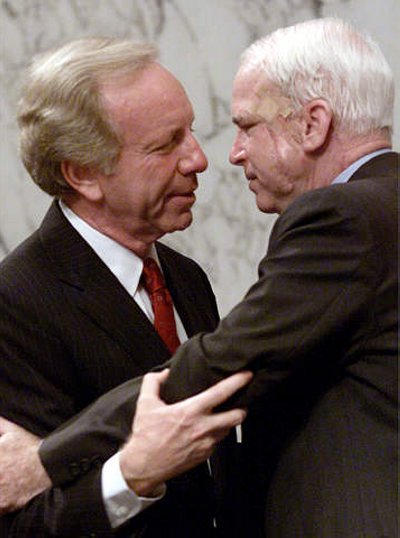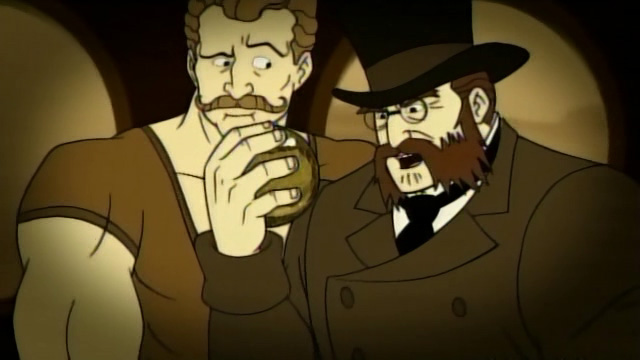Lieberman resists Medicare buy-in plan
By CALVIN WOODWARD

WASHINGTON (AP) - Risking the wrath of Democrats, Sen. Joseph Lieberman, I-Conn., threatened Sunday to join Republicans in opposing health care legislation if it permits uninsured individuals as young to 55 to purchase Medicare coverage.
Lieberman, whose vote is critical to the bill's prospects, expressed his opposition twice during the day: first in an interview with CBS, and more strongly later, according to Democratic officials, in a private meeting with Senate Majority Leader Harry Reid.
Reid, who is hoping to pass the legislation by Christmas, needs 60 votes to overcome Republican objections, and has been counting on Lieberman to provide one.
But appearing on CBS, Lieberman said of the Medicare proposal, "Though I don't know exactly what's in it, from what I hear, I certainly would have a hard time voting for it because it has some of the same infirmities that the public option did.
"It will add taxpayer costs. It will add to the deficit. It's unnecessary," he added of a provision that Reid last week hailed as part of a breakthrough between liberals and moderates.
Democratic aides, speaking on condition of anonymity, said Lieberman later told Reid he would support a Republican-led filibuster against the bill if it contained the Medicare provision or permitted the government to sell insurance in competition with private companies.
The same aides added that Lieberman had responded differently last week when Reid asked him privately about the proposed Medicare provision. "He voiced support for the idea," said one official. Lieberman's public comments last week were also generally favorable. The aides spoke on condition of anonymity, saying they was not authorized to comment publicly.
In an interview that aired Sunday night - but was recorded last week - President Barack Obama voiced optimism about his call for sweeping legislation to expand coverage while cracking down on the insurance industry.
"I think it's going to pass out of the Senate before Christmas," he told CBS'"60 Minutes."
If Lieberman follows through on his plans, he leaves Democrats with few options as they try and pass legislation before Christmas. Most obviously, they could strip out the provisions he opposes, and hope liberals overcome their inevitable unhappiness and vote for the bill. For that approach to have any chance of success, Obama would have to lobby heavily in its favor.
The bill's supporters could turn to Republicans instead in search of support, but that is unlikely to produce a compromise in the next few days.
Democrats are not without political leverage, however. Lieberman lost the Democratic nomination for re-election the last time he ran, in 2006, then won a new term as an independent. Even so, he retains his chairmanship of the Homeland Security and Government Affairs Committee, a post he holds at the pleasure of the Democratic-controlled Senate.
On CBS, Lieberman pleaded with Democrats to start subtracting expensive proposals from the overhaul, saying, "We don't need to keep adding onto the back of this horse or we're going to break the horse's back and get nothing done."
While Lieberman drew most of the attention for his comments, Democratic Sens. Claire McCaskill of Missouri and Ben Nelson of Nebraska also expressed concern about the legislation.
"I'm concerned that it's the forerunner of single-payer - the ultimate single-payer plan, maybe even more directly than the public option," Nelson said of the Medicare proposal. By single-payer, he meant national health insurance run by Washington. Unlike Lieberman, Nelson participated in negotiations last week between liberals and moderates that produced the general framework that included the Medicare provision.
Nelson also is seeking stricter abortion restrictions than are currently in the bill.
"The whole reason we're doing this bill is to bring down cost, first for the American people in health care, and secondly for the deficit," said Democratic Sen. Claire McCaskill of Missouri. "So until we get the numbers back from the Congressional Budget Office, we're all on hold."
Asked if she would vote against the bill if it raised health care costs overall, she said, "Absolutely."
In the meantime, only a few moderates have come out against the Medicare plan. But in a legislative struggle that is a game of inches, Democrats need all 60 votes in their caucus, and they don't yet have them.
Senate GOP leader Mitch McConnell gave no indication of backing down. "With the American people as overwhelmingly opposed to this bill as they are, for the Democrats to basically, arrogantly take the position that we're going to ignore public opinion and jam this through before Christmas, I think that's really a stretch," said McConnell, R-Ky.
The early Medicare buy-in was part of a compromise reached last week when Senate Democrats dropped the idea of setting up a federal health insurance plan to compete with private insurers. Lieberman was a firm opponent of the bill's original plan for a public insurance option.
Many Democrats who had favored that public option only grudgingly let it go, in return embracing the Medicare proposal as an appealing way to help people 55 to 64 - a group often vulnerable to losing employer-based health insurance when it's needed the most.
Under the compromise, private nonprofit plans overseen by the federal government would be offered in the marketplace.
Sen. Jay Rockefeller, D-W.Va., said he was working with Lieberman and others on controlling Medicare costs, and he voiced confidence fellow Democrats could get past their divisions. Party leaders are pushing hard to finish the Senate overhaul legislation before Christmas and to begin negotiations with the House, which has passed its plan.
Lieberman, Nelson, McConnell and Rockefeller spoke on CBS'"Face the Nation." McCaskill was on "Fox News Sunday."
Joe Lieberman Lies About Bush Kiss: Someone should ask Traitor Joe why he wants to fuck the American People without a kiss while he'd go to 2nd Base with the evil puppet head Bush.
And I caught this via twitter -
Latest results for Joe Lieberman
- PauseSarah Palin Goes 'Birther': Obama Birth Certificate 'A Fair Question' (VIDEO)
Sarah Palin declared on Thursday that the legitimacy of President Obama's birth certificate is "rightfully" an issue with the American public, and that it is "fair game" for politicians to question Obama's citizenship.The comments came during an interview with conservative radio host Rusty Humphries, who asked Palin whether she planned to "make the birth certificate an issue" if she runs for president in 2012.
"I think the public rightfully is still making it an issue," Palin said. "I don't have a problem with that. I don't know if I would have to bother to make it an issue, because I think that members of the electorate still want answers."
Humphries -- who began the interview with a rendition of the song "Sarah, Queen Of The Wild Frontier" -- followed up: "Do you think it's a fair question to be looking at?"
"I think it's a fair question just like I think past associations and past voting records. All of that is fair game," Palin responded, adding that "the McCain-Palin campaign didn't do a good enough job in that area. We didn't call out Obama and some of his associates on their records and what their beliefs were, and perhaps what their future plans were, and I don't think that was fair to voters to not have done our job as candidates and a campaign to bring to light a lot of things that now we're seeing manifest in the administration."
Palin later referenced "that weird conspiracy theory freaky thing that people talk about that Trig isn't my real son, and a lot of people that went 'Well, you need to produce his birth certificate, you need to prove that he's your kid,' which we have done, but yeah, so maybe we can reverse that, and use the same [inaudible] thinking on the other one."
UPDATE: At 1:16 AM ET, Palin posted the following on her Facebook page:
Stupid Conspiracies
Voters have every right to ask candidates for information if they so choose. I've pointed out that it was seemingly fair game during the 2008 election for many on the left to badger my doctor and lawyer for proof that Trig is in fact my child. Conspiracy-minded reporters and voters had a right to ask... which they have repeatedly. But at no point - not during the campaign, and not during recent interviews - have I asked the president to produce his birth certificate or suggested that he was not born in the United States.
WATCH:
FactCheck.org has done the most comprehensive debunking of the various conspiracy theories related to Obama's citizenship. Here is their bottom line:
In June, the Obama campaign released a digitally scanned image of his birth certificate to quell speculative charges that he might not be a natural-born citizen. But the image prompted more blog-based skepticism about the document's authenticity. And recently, author Jerome Corsi, whose book attacks Obama, said in a TV interview that the birth certificate the campaign has is "fake."
We beg to differ. FactCheck.org staffers have now seen, touched, examined and photographed the original birth certificate. We conclude that it meets all of the requirements from the State Department for proving U.S. citizenship. Claims that the document lacks a raised seal or a signature are false. We have posted high-resolution photographs of the document as "supporting documents" to this article. Our conclusion: Obama was born in the U.S.A. just as he has always said.
(H/T Ben Smith and Jed Lewison)
But it gets better —
Palin's Father: She Left Hawaii Because Asians Made Her Uncomfortable
Did Sarah Palin leave Hawaii because there were too many Asians? In the New Yorker review of "Going Rogue," Sam Tanenhaus writes that Palin's father suggested as much to the reporters who wrote "Sarah From Alaska." The account contradicts the former Alaska governor's own description of her reasons for leaving college in Hawaii after only one semester.Palin, though notoriously ill-traveled outside the United States, did journey far to the first of the four colleges she attended, in Hawaii. She and a friend who went with her lasted only one semester. "Hawaii was a little too perfect," Palin writes. "Perpetual sunshine isn't necessarily conducive to serious academics for eighteen-year-old Alaska girls." Perhaps not. But Palin's father, Chuck Heath, gave a different account to Conroy and Walshe. According to him, the presence of so many Asians and Pacific Islanders made her uncomfortable: "They were a minority type thing and it wasn't glamorous, so she came home." In any case, Palin reports that she much preferred her last stop, the University of Idaho, "because it was much like Alaska yet still 'Outside.' "
The passage was first flagged by Issac Chotiner at The New Republic, who wondered why it hadn't gotten any media attention.





















 for Science News —
for Science News — Art by Barron Storey
Art by Barron Storey


